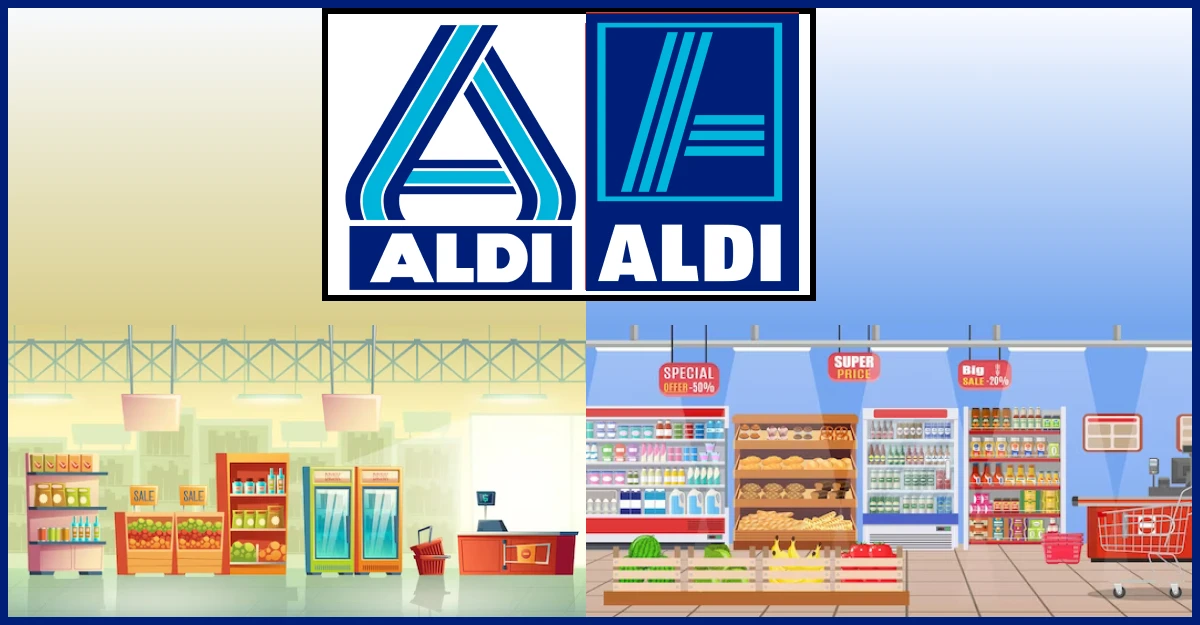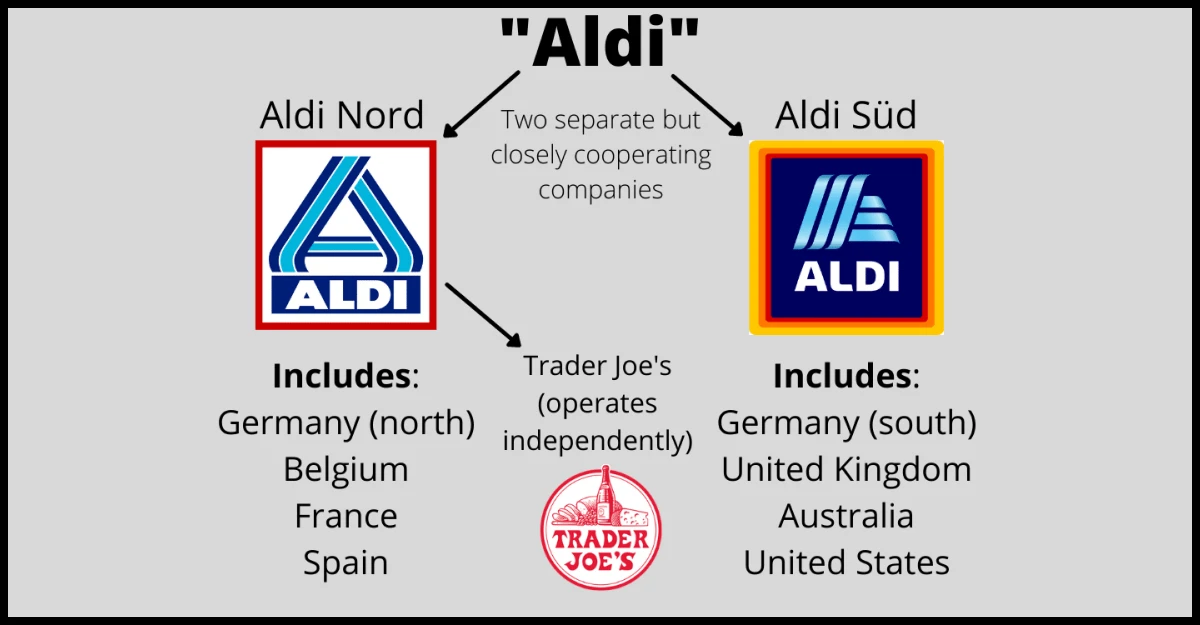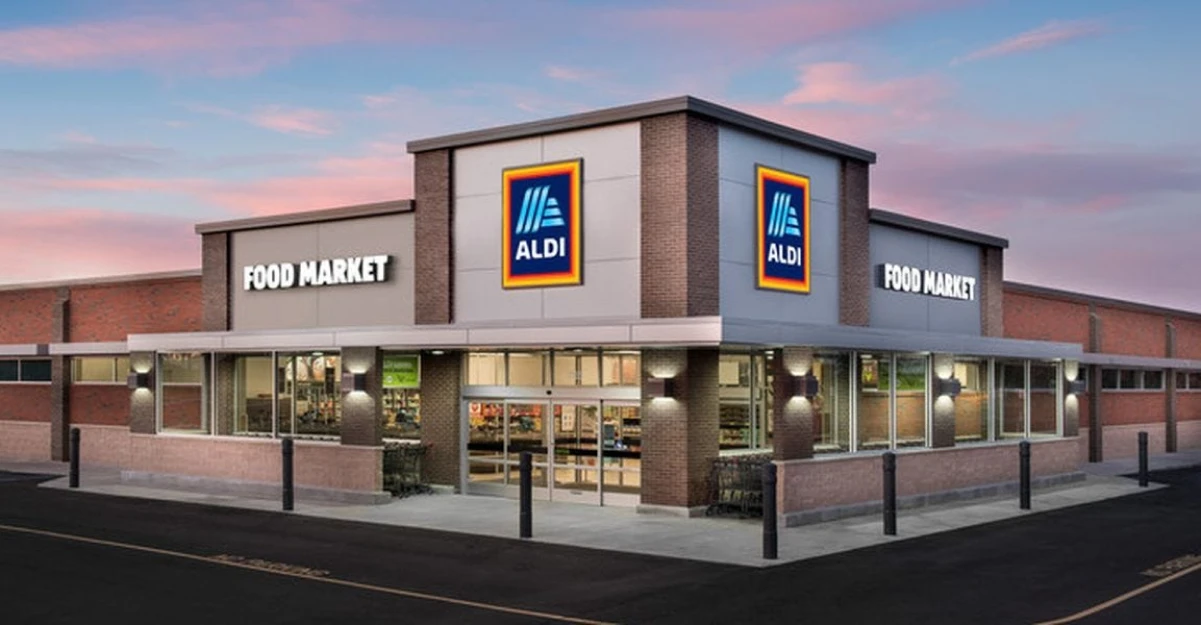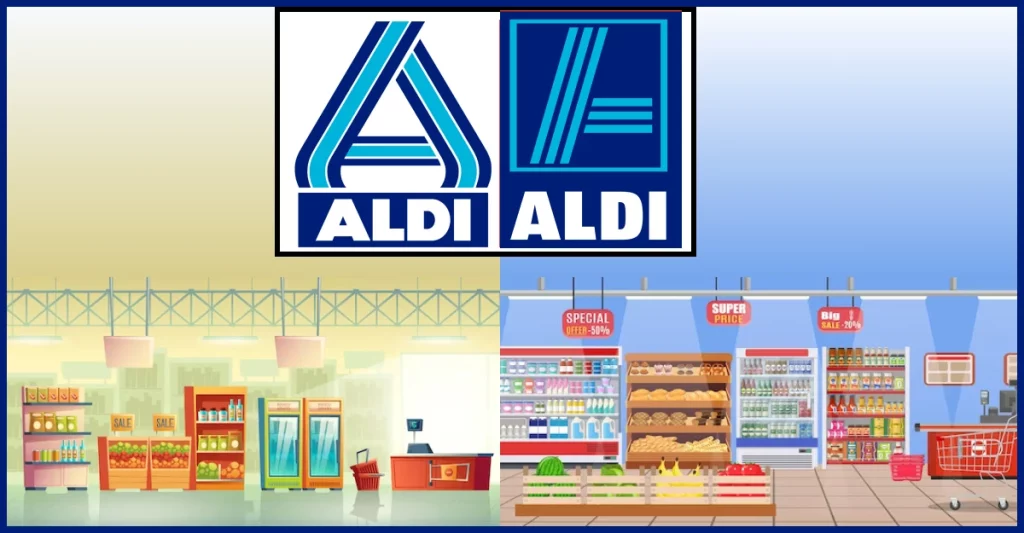In the competitive landscape of the retail industry, Aldi has carved out a distinct niche, especially in Europe! All thanks to the innovative and highly effective Aldi business model! While many retailers chase trends and flashy displays, Aldi takes a different approach. Its business strategy is like a well-guarded recipe, blending simplicity, efficiency, and customer-centricity into a formula that consistently delivers success.

But that’s just the tip of the iceberg. To fully understand how Aldi manages to thrive in a market saturated with options. You need to dive deep into the layers of the Aldi business model.
So, let’s delve into the Aldi business model!
(A) Aldi: The Company’s Profile
| Company’s Name | Aldi |
| Type of Company | Private |
| Industry (Operating Segment) | Retail |
| Founded | 10 July 1946 |
| Founders | Karl Albrecht Theo Albrecht |
| Split | 1960: Aldi Nord 1962: Aldi Sud |
| Headquarters | Essen, Germany (Aldi Nord) Mulheim, Germany (Aldi Sud) |
| Presence | Worldwide (11,235 locations) |
| Products | Supermarket Hypermarket Superstore Convenience store |
| Revenue (2022) | $121.1 billion |
| Subsidiaries of Aldi Nord | Trader Joe’s |
| Subsidiaries of Aldi Sud | Hofer, Winn-Dixie |
(B) Aldi in a Nutshell
The term “Aldi” represents the shared corporate identity of two German multinational discount supermarket chains founded by brothers Karl and Theo Albrecht in 1946, who initially took over their mother’s store in Essen. This retail conglomerate operates an extensive network of over 10,000 stores across 20 different countries.
In 1960, the business underwent a division, resulting in the establishment of Aldi Nord, headquartered in Essen, and Aldi Süd, headquartered in Mülheim. The name “Aldi,” derived from “Albrecht Diskont,” was officially introduced in 1962. In Germany, these two entities have functioned as separate entities since 1966, although they may sometimes seem like a unified organization due to shared store branding and business partnerships.
Formally, Aldi Nord operates under the business name Aldi Einkauf GmbH & Co., while Aldi Süd operates as ALDI SÜD Dienstleistungs-SE & Co. Both companies maintain their independence but engage in contractual collaborations.

In Germany, Aldi Nord comprises 35 regional companies with approximately 2,500 stores in western, northern, and eastern regions, while Aldi Süd consists of 32 regional companies with 1,900 stores primarily in western and southern Germany.
(B.1) Areas Served by Aldi Nord
- Denmark
- France
- Benelux countries (Belgium, the Netherlands, and Luxembourg)
- Portugal
- Spain
- Poland
(B.2) Areas Served by Aldi Süd
- Ireland
- United Kingdom
- Hungary
- Switzerland
- Australia
- China
- Italy
- Austria
- Slovenia
Notably, both Aldi Nord (owner of Trader Joe’s) and Aldi Süd operate in the United States, collectively managing around 1,600 stores as of 2017. The United States stands as the sole country outside of Germany where both Aldi entities coexist.
Furthermore, on August 16, 2023, it was officially announced that ALDI had entered into a definitive agreement to acquire Southeastern Grocers. It is a Jacksonville, Florida-based company known for its ownership of the Winn-Dixie and Harvey Supermarkets brands.
Note: We have also covered the retail giants of America namely “Walmart vs Target.” Do check it out for more information.
(C) Working Strategy: How does Aldi work?
Aldi’s unique working strategy as a discount supermarket chain is built on several key principles. It aims to maximize efficiency, and cost-cutting, and maintain simplicity in its operations.
Let’s have a brief overview of Aldi’s operational/working strategies-
| Key Aspects | Aldi’s Working Strategies |
| Product Selection | Limited selection to reduce complexity and costs. |
| Private Labels | Relies heavily on private-label products. |
| Store Design | Simple, no-frills layout |
| Store Staffing | Efficient and cross-trained staff |
| Store Size | Smaller footprint compared to traditional supermarkets |
| Special Buys | Weekly limited-time offers on non-grocery items. |
| Supply Chain | Streamlined supply chain, often working directly with suppliers |
| Advertising | Minimal advertising expenditure |
| Brands | Focuses on private-label brands for control over pricing and quality. |
| Quality and Value | Emphasis on offering good quality and value to customers. |
| Rotating Product Selection | Includes seasonal and specialty items. |
Now, let’s look at the detailed breakdown of how Aldi works-
(C.1) Limited Selection
Aldi intentionally offers a limited selection of products compared to traditional supermarkets. This strategy serves several purposes-
- It minimizes operational complexities in stocking and replenishing inventory.
- Reduces the need for large storage space, which helps cut rent and storage costs.
- Allows Aldi to negotiate better prices with suppliers since they focus on a smaller range of products.
(C.2) Private Labels
Aldi heavily relies on its private-label or store-brand products. These products are often more affordable than well-known name brands, allowing Aldi to maintain low prices while still controlling product quality.
(C.3) No Frills Store Design
Aldi’s stores are designed with a “no-frills” approach. They use the following tactics-
- Simple and functional store layouts with minimal decorations.
- Utilization of pallets for product displays, which saves on store setup costs and presents products efficiently.
(C.4) Cost-Effective Staffing
Aldi keeps labor costs in check by cross-training employees to perform various tasks. Efficiency and speed during checkout are emphasized, with customers often required to bag their groceries. Additionally, Aldi employs a cart deposit system to encourage customers to return their shopping carts, reducing labor and cart retrieval costs.
(C.5) Smaller Store Footprint
Aldi’s stores are typically smaller in size compared to traditional supermarkets. This reduction in store size results in lower rent and operational expenses, contributing to cost savings.
(C.6) Aldi Special Buys
Aldi features weekly “Special Buys” on non-grocery items like clothing, electronics, and home goods. These limited-time offers create a sense of urgency, encouraging customers to visit Aldi frequently to discover new deals and products.
(C.7) Efficient Supply Chain
Aldi maintains a streamlined supply chain by often working directly with suppliers. By cutting out middlemen, they negotiate better deals, maintain product quality control, and prioritize efficient logistics and inventory management.
(C.8) Minimal Advertising

Aldi spends significantly less on advertising compared to its competitors. Instead, they rely on word-of-mouth, in-store promotions, and the allure of their Special Buys to attract customers.
(C.9) Store Brands
The majority of products available at Aldi are private-label brands. This strategy allows Aldi to maintain control over pricing and product quality, offering customers a balance between affordability and quality.
(C.10) Focus on Quality and Value
Aldi places a strong emphasis on offering good-quality products at lower prices. They conduct blind taste tests and quality assessments to ensure their private-label items meet or exceed the quality of national brands.
(C.11) Rotating Product Selection
While many staple products remain consistent, Aldi’s inventory also includes rotating seasonal and specialty items. This approach keeps the shopping experience interesting and encourages customers to explore the store regularly.
(C.12) Why is Aldi so cheap?
Because of its efficient working strategy. Its operations revolve around simplicity, cost-saving measures, and a relentless focus on offering value to customers. By reducing overhead costs and optimizing their supply chain, Aldi provides quality products at lower prices, making them a preferred choice for budget-conscious shoppers.
(D) Revenue Sources: How does Aldi make money?
Aldi is a special kind of grocery store that cleverly makes money. They don’t have fancy stores or lots of choices like other supermarkets. Instead, they focus on saving money in smart ways. They make their brands, which helps them cut costs. Plus, they keep things super simple to save even more money. This makes their prices low, and people love that!
But there’s more to their success. To find out all the cool tricks Aldi uses to make money, read the diverse revenue sources described below-
| Aldi Revenue Sources | Description |
| Retail Sales | Sales of groceries and everyday essentials. |
| Private-Label Brands | Sales of Aldi’s private-label products. |
| Store Expansion | Revenue from opening new Aldi stores. |
| Special Buys | Sales of limited-time, unique items. |
| Non-Grocery Items | Sales of non-grocery products |
| Aldi Nord and Aldi Süd | Revenue from separate companies in different regions |
| Aldi Online | Revenue from online sales and delivery services |
| Real Estate | Rental income from owned store properties |
| Supplier Relationships | Cost savings and potentially higher margins |
This table has outlined and briefly described various revenue sources of Aldi. Now, it is time to dive deeper into the details of “How does Aldi make money?”
(D.1) Retail Sales
Aldi’s primary source of revenue comes from its core business of selling groceries and everyday essentials. They offer a carefully curated selection of high-quality, private-label products at competitive prices. The revenue is generated through the sale of these products to customers who shop at Aldi stores.
(D.2) Revenue from Private-Label Brands
Aldi places a strong emphasis on its private-label brands, such as “Aldi Finds” and “Simply Nature.” Instead of carrying many well-known national brands, Aldi creates and markets its products under these private labels. This strategy allows Aldi to have better control over product quality and pricing, ultimately leading to higher revenue from the sales of these private-label items.
(D.3) Store Expansion
Aldi continually expands its retail footprint by opening new stores in various regions and markets. Each new store represents a new revenue-generating location, contributing to Aldi’s overall revenue growth.
Let’s look at the presence of Aldi Sud stores in different countries–
| Countries | Number of Aldi Sud Stores |
| United States | 2,150 |
| Germany | 1,980 |
| China | 22 |
| Europe | All the remaining ones |
Now, let’s look at the presence of Aldi Nord stores in different countries–
| Country | Number of Aldi Nord Stores |
| France | 891 |
| The Netherlands | 491 |
| United States (As Trader Joe’s) | 474 |
| Belgium | 457 |
| Spain | 264 |
| Denmark | 222 |
| Poland | 124 |
| Portugal | 48 |
(d.4) Special Buys
Aldi’s “Special Buys” section features limited-time, unique items that change weekly. These exclusive and discounted offers attract shoppers looking for deals and unique products, leading to additional sales and revenue during these promotional periods.
(D.5) Non-Grocery Items
Although Aldi business model is primarily known as a grocery store, it also offers a limited range of non-grocery items such as household goods, electronics, and seasonal items. Revenue is generated from the sales of these supplementary products, diversifying their income streams.
(D.6) Aldi Nord and Aldi Süd
Aldi operates as two separate companies, Aldi Nord and Aldi Süd, each with its geographic focus. Aldi Nord primarily operates in Northern Europe, while Aldi Süd operates in Southern Europe, the United States, and other regions. This division allows them to tailor their strategies to local markets and generate revenue independently.
(d.7) Aldi Online
Depending on the region, Aldi may offer online shopping and delivery services through its website or dedicated apps. These online sales contribute to revenue, especially in markets where e-commerce is prevalent.
(D.8) Real Estate
Aldi often owns the real estate where its stores are located. In some cases, they lease surplus properties to other businesses, generating rental income as an additional revenue stream.
(D.9) Supplier Relationships
Aldi maintains strong relationships with suppliers and is known for negotiating favorable terms. This allows Aldi to secure competitive pricing and terms, contributing to cost savings and potentially higher margins on the products they sell.
Overall, Aldi’s revenue comes from a diverse range of sources, with a core focus on retail sales of private-label groceries. Their strategic initiatives, including store expansion, online presence, and effective supplier relationships, contribute to their success in generating revenue while offering value to their customers.
(E) Marketing Strategies of Aldi
As you have read in the section on “Aldi working strategies,” the firm doesn’t spend much on advertisements. But it successfully expanded throughout Europe. Isn’t it? How was it possible without spending a single penny on advertisements? Well, they used clever and highly effective marketing strategies that helped it to gain a strong foothold in the entire Europe.
Let’s have a brief look at various marketing strategies of Aldi-
| Aldi Marketing Strategies | Description |
| EDLP (Everyday Low Prices) | Consistent low pricing for affordability. |
| Use of Private Label Brands | Lower-priced private-label alternatives. |
| Minimalist Store Design | Efficient, no-frills store layout to reduce costs. |
| Rotating Product Selection | Seasonal and limited-time “Aldi Finds” for repeat visits. |
| Quality Assurance | “Double Guarantee” policy for product quality and satisfaction. |
| Special Buys and Weekly Ads | Promotions through weekly ads and limited-time discounts. |
| Sustainability Initiatives | Eco-friendly practices and reduced plastic usage. |
| Customer-Centric Approach | Customer feedback-driven improvements. |
| Aggressive Expansion | Global store expansion for wider reach. |
| Digital Presence | Online shopping, social media, and email marketing. |
| Community Engagement | Local community involvement through charity and sponsorships. |
Aldi, a global supermarket chain, employs several key marketing strategies to attract and retain customers. The following points provide a thorough breakdown of Aldi’s marketing strategies-
(E.1) EDLP (Everyday Low Prices)
Aldi is known for its commitment to offering consistently low prices on a wide range of products. This strategy helps them compete with larger retailers by emphasizing affordability. They achieve this through cost-saving measures, such as limited product selection, private labeling, and efficient supply chain management.
(E.2) Private Label Brands
Aldi primarily stocks its shelves with private label brands, which are often priced lower than national brands. These private labels, such as “Specially Selected” or “Simply Nature,” provide quality alternatives to name-brand products. This approach also helps Aldi maintain control over pricing and product quality.
(E.3) Minimalist Store Design
Aldi stores have a simple and efficient layout, typically with limited decoration and few frills. This approach helps reduce operating costs, allowing them to pass savings on to customers.
(E.4) Rotating Product Selection
Aldi frequently rotates its product selection, offering a mix of seasonal and limited-time items. This “Aldi Finds” section creates a sense of urgency among shoppers, encouraging repeat visits.
(E.5) Quality Assurance
Despite low prices, Aldi maintains a strong focus on product quality. They offer a “Double Guarantee” policy, allowing customers to return a product and receive a refund or replacement if they are not satisfied.
(E.6) Special Buys and Weekly Ads
Aldi publishes weekly ads showcasing their current deals and promotions. These ads highlight limited-time discounts on select products, driving foot traffic to the stores.
(E.7) Sustainability Initiatives
Aldi has made strides in promoting sustainability by reducing plastic packaging, sourcing sustainable seafood, and offering organic and eco-friendly products. This appeals to environmentally conscious consumers.
(E.8) Customer Centric Approach
Aldi actively listens to customer feedback and adjusts its offerings accordingly. They use customer insights to improve products and services.
(E.9) Aggressive Expansion

Aldi has been expanding its footprint globally, including in the United States. By increasing the number of stores, they aim to reach a broader customer base and increase brand recognition.
(E.10) Digital Presence
Aldi has embraced e-commerce and offers online shopping and delivery services in some regions. They also utilize social media and email marketing to engage with customers and promote special offers.
(E.11) Community Engagement
Aldi business model engages with local communities through charitable initiatives and sponsorships. This fosters a positive image and strengthens ties with customers.
Thus, Aldi’s marketing strategies are rooted in providing high-quality products at low prices. Especially, through cost-effective operations, private label brands, and a customer-centric approach. Their focus on sustainability and community involvement also contributes to their brand appeal.
(F) Conclusion of Aldi Business Model
By now you must have understood how this century-old company has gained a strong foothold in Western countries. Aldi business model thrives on delivering exceptional value while maintaining operational efficiency.
At its core, Aldi’s success can be distilled into several key takeaways. First and foremost, it prioritizes cost leadership, consistently offering low prices through private labels, minimalistic store layouts, and a highly efficient supply chain. Second, its emphasis on private-label brands grants better control over product pricing and quality, ensuring affordability without compromising quality.
Additionally, Aldi’s customer-centric approach, rooted in actively listening to customer feedback, fosters satisfaction and drives continuous product improvements. Lastly, the company’s commitment to sustainability resonates with environmentally conscious consumers.
In essence, Aldi’s enduring profitability arises from its ability to offer quality products at affordable prices. It is driven by a robust supply chain, private labels, and customer-centricity. That’s how the Aldi business model played a key role in its success while embracing sustainability!

